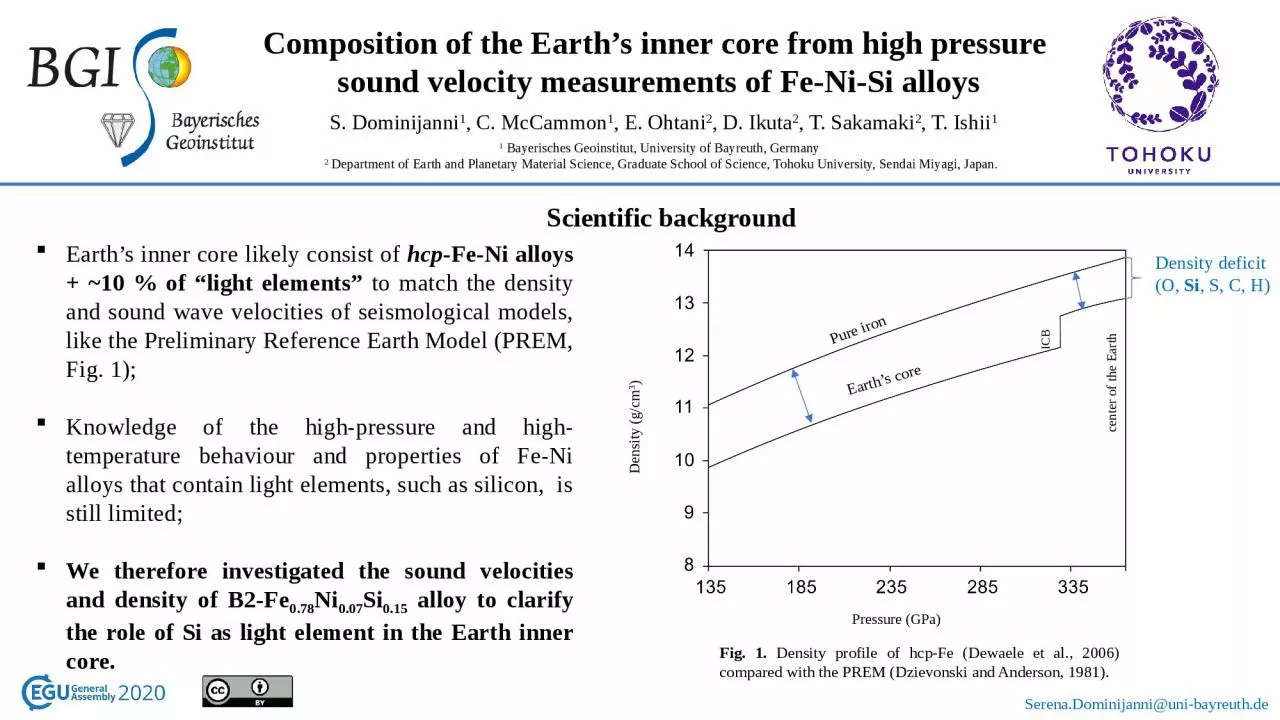

sound velocity measurements of FeNiSi alloys S Dominijanni 1 C McCammon 1 E Ohtani 2 D Ikuta 2 T Sakamaki 2 T Ishii 1 SerenaDominijanniunibayreuthde 1 Bayerisches Geoinstitut University of Bayreuth Germany ID: 1036755
Download Presentation The PPT/PDF document "Composition of the Earth’s inner core ..." is the property of its rightful owner. Permission is granted to download and print the materials on this web site for personal, non-commercial use only, and to display it on your personal computer provided you do not modify the materials and that you retain all copyright notices contained in the materials. By downloading content from our website, you accept the terms of this agreement.
1. Composition of the Earth’s inner core from high pressure sound velocity measurements of Fe-Ni-Si alloysS. Dominijanni1, C. McCammon1, E. Ohtani2, D. Ikuta2, T. Sakamaki2, T. Ishii1Serena.Dominijanni@uni-bayreuth.de1 Bayerisches Geoinstitut, University of Bayreuth, Germany 2 Department of Earth and Planetary Material Science, Graduate School of Science, Tohoku University, Sendai Miyagi, Japan.Scientific backgroundEarth’s inner core likely consist of hcp-Fe-Ni alloys + ~10 % of “light elements” to match the density and sound wave velocities of seismological models, like the Preliminary Reference Earth Model (PREM, Fig. 1);Knowledge of the high-pressure and high-temperature behaviour and properties of Fe-Ni alloys that contain light elements, such as silicon, is still limited;We therefore investigated the sound velocities and density of B2-Fe0.78Ni0.07Si0.15 alloy to clarify the role of Si as light element in the Earth inner core. Pressure (GPa)Density (g/cm3)Density deficit (O, Si, S, C, H)center of the EarthPure ironEarth’s coreICBFig. 1. Density profile of hcp-Fe (Dewaele et al., 2006) compared with the PREM (Dzievonski and Anderson, 1981).
2. Experimental methodsSynthesis of the sample Multi anvil apparatus – Pressure 8(1) GPa, Temperature 1200(50) °CStarting material: Fe (0.78 wt. %), Ni (0.07 wt. %), Si (0.15 wt. %)2) Analyses of the run productsSEM analysis were performed to verify the homogeneity of the sample (Fig. 2)3) High pressure experiments in diamond anvil cell (DAC)Inelastic X-ray scattering (IXS): SPring-8 synchrotron facility (BL35XU beamline, JP)Powder X-ray diffraction (XRD): DESY synchrotron facility (P02.02, PETRA III, DE)Data processing IXS spectra were fitted using Lorentzian functionsXRD patterns have been refined with the LeBail method20 µmFig. 2. Backscattered electron image of the synthesized sample.Fig. 3. Schematic diagram of a BX90 type diamond anvil cell.
3. Discussions and conclusions Fig. 4. Birch’s law of B2-Fe0.78Ni0.07Si0.15 alloy compared with previous studies of pure Fe (a) Fe-Si (b) and Fe-Ni-Si alloys (c). The relation of the sound wave velocities VP (m/s), Vs (m/s) and density ρ (kg/m3) follows Birch’s law (i.e. there is a linear relationship between density and sound velocities): aComparison with Fe-Si alloys Comparison with Fe-Ni-Si alloys Comparison with pure Fe bc
4. Discussions and conclusions Our results compared with previous studies suggest that the presence of Si in the alloy reduces both density and sound velocities (Vp and Vs) of iron in the Earth’s inner core. This can be clearly observed in Fig. 5, in which our Birch’s law extrapolated at inner core boundary (ICB) conditions provides a closer match to PREM than pure iron. Based on the results of this study we suggest that a combination of bcc-Fe0.78Ni0.07Si0.15 alloy and hcp-Fe is a viable candidate to match with the geophysical observations of Earth’s inner core.Fig. 5. Comparison of the proposed density dependence of the aggregate compressional (Vp) and shear (Vs) sound velocities with the PREM (Dzievonski and Anderson, 1981).